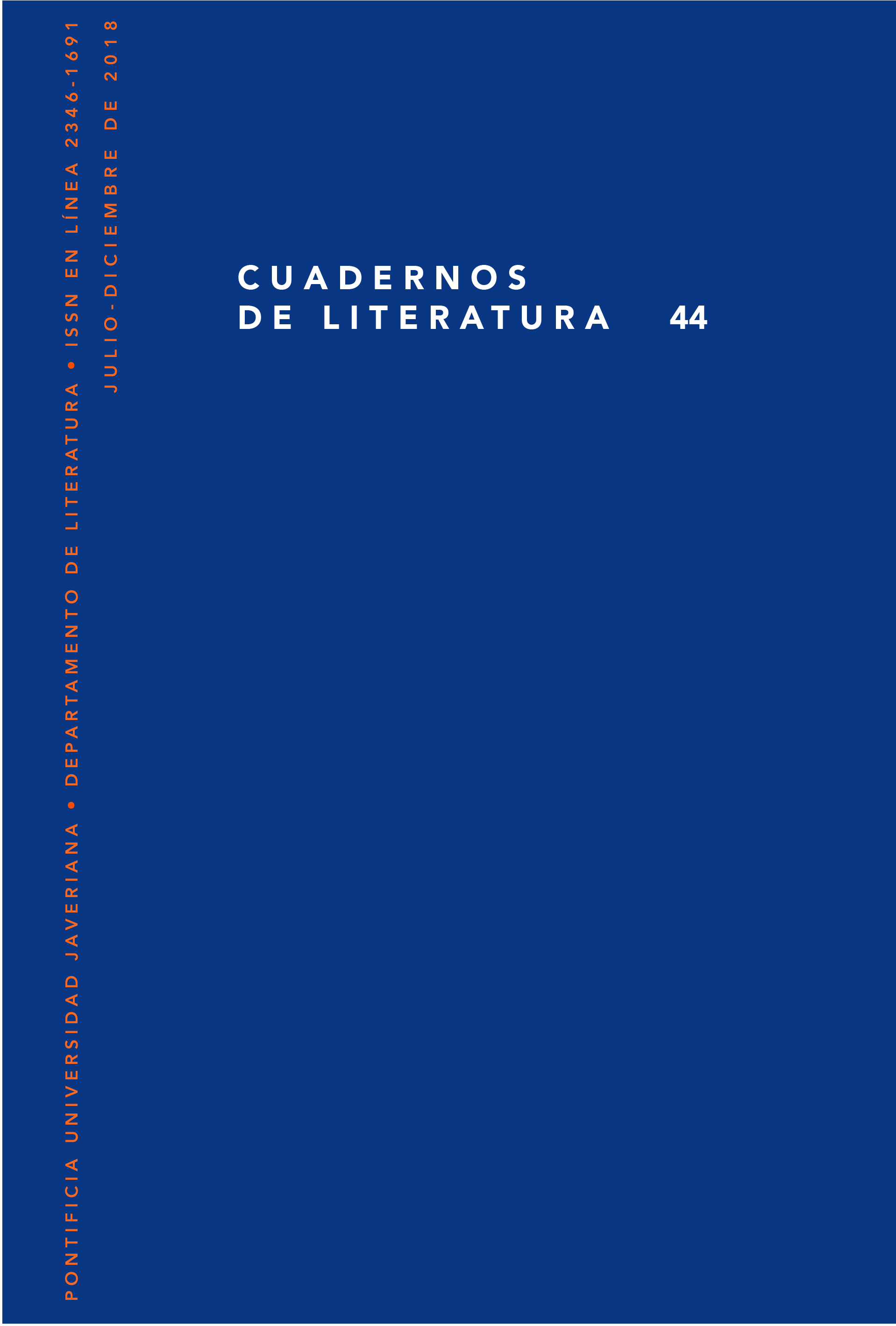Abstract
This article analyzes how three films by the Argentine director Gustavo Fontán that emerged from a river’s literary tradition “paint” a river by exploring the relations between subject and landscape through haptic and sensorial dimensions. Moving away from the traditional film and documentary narratives, La orilla que se abisma (2008), El rostro (2013) y El limonero real (2016) center on an aesthetic and perceptive intensification to discover a new idea of experience which helps redraw the affective geography of the Argentine littoral.
Andermann, Jens. “Paisaje: imagen, entorno, ensamble”. Geografías culturales: aproximaciones, intersecciones y desafíos. Eds. Perla Zusman, Rogério Haesbaert y Hortensia Castro. Buenos Aires: Eudeba, 2011. 277-290. Impreso.
Biedma, Salvador. “Al otro lado del río”. Suplemento Radar, Página12 (28 de agosto de 2016). https://www.pagina12.com.ar/ diario/suplementos/radar/9-11745-2016-08-28.html. Web.
Bilbao, Horacio. “Los discursos cerrados me provocan desconfianza”. Clarín (5 de septiembre de 2016). http://www.clarin.com/extra-show/cine/entrevistagustavo-fontan-saer-limonero-real_0_BJE1fOws.amp.html. Web.
Bruno, Giuliana. Atlas of Emotion. Journeys in Art, Architecture, and Film. Nueva York: Verso, 2002. Impreso.
Bruno, Giuliana. Surface: Matters of Aesthetics, Materiality, and Media. Chicago: University of Chicago Press, 2014. Impreso.
Conti, Haroldo. Sudeste. Buenos Aires: Emecé, 2005. Impreso.
Corrigan, Timothy. Film and Literature: An Introduction and Reader. London: Routledge, 2012. Impreso.
Dalmaroni, Miguel y Margarita Merbilha. “Un azar convertido en don. Juan José Saer y el relato de la percepción”. Historia Crítica de la Literatura Argentina. Buenos Aires: Emecé, 2000. Impreso.
Deleuze, Gilles. Francis Bacon. Lógica de la sensación. Trad. Isidro Herrera. Madrid: Arena Libros, 2005. Impreso.
Depetris Chauvin, Irene. “Cómo pintar un río”. Informe Escaleno (abril de 2014). http://www.informeescaleno.com.ar/index.php?s=articulos&id=144. Web.
Depetris Chauvin, Irene. “Volver a mirar (Una conversación con Gustavo Fontán)”. Informe Escaleno (abril de 2014). http:// www.informeescaleno.com.ar/articulos153. Web.
Dudley, Andrew. “Adaptation”. Film Theory and Criticism. Eds. Leo Braudy y Marshall Cohen. Oxford: Oxford University Press, 1992. 420-429. Impreso.
Elsaesser, Thomas y Malte Hagener. Film Theory: An Introduction Through the Senses. New York: Routledge, 2015. Impreso.
Fontán, Gustavo, dir. El limonero real. 2016. Filme.
Fontán, Gustavo, dir. El rostro. 2012. Filme.
Fontán, Gustavo, dir. La orilla que se abisma. 2008. Filme.
Fontán, Gustavo. “Modos de penetrar el mundo”. Dossier “Mutaciones y migraciones en las artes audiovisuales”. Arkadin 6.4 (mayo de 2012): 7-11. Impreso.
Gamberini, Marcela. “El limonero real. El sueño eterno” (septiembre de 2016). http://ojosabiertos.otroscines.com/el-limonero-real03/#comment-1006611. Web. 1 de febrero de 2017.
Gumbrecht, Hans Ulrich. Production of Presence: What Meaning Cannot Convey. Stanford: Stanford University Press, 2004. Impreso.
Hernaiz, Sebastián. “Notas sobre el río en la literatura argentina 2”. El interpretador 33 (mayo 2008). https://revistaelinterpretador.wordpress.com/2016/10/24/ notas-sobre-el-rio-en-la-literatura-argentina-2. Web.1 de diciembre de 2016.
Koza, Roger. “De la buena glosa cinematográfica. Diálogo sobre El limonero real con Gustavo Fontán”. Septiembre de 2016. http://ojosabiertos. otroscines.com/de-la-buena-glosa-cinematografica-un-dialogo-sobreel-limonero-real-con-gustavo-fontan. Web.1 de febrero de 2017.
Koza, Roger. “El plano que se abisma. El cine de Gustavo Fontán”. http:// ojosabiertos.otroscines.com/mes-ficunam-2014-07-el-plano-que-seabisma-el-cine-de-gustavo-fontan. Web.: 20 de abril de 2015.
Marks, Laura. The Skin of the Film. Intercultural Cinema, Embodiment, and the Senses. Durham: Duke UP, 2000. Impreso.
Martins, Laura. “Contra la museificación del mundo: La orilla que se abisma (2008) y La casa (2012) de Gustavo Fontán”. Studies in Spanish & Latin American Cinemas 11.2 (2014): 167-177. Impreso.
Mistral, Gabriela. Grandeza de los oficios: selección de prosas. Santiago de Chile: Andrés Bello, 1979. Impreso.
Montaldo, Graciela. Juan José Saer. El limonero real. Buenos Aires: Hachette, 1986. Impreso.
Moure, Clelia. “La ausencia de la dicotomía sujeto-objeto en la poesía de Juan L. Ortiz”. Cuadernos para investigación de la literatura hispánica 30 (2005): 365-378. Impreso.
Nichols, Bill. La representación de la realidad. Cuestiones y conceptos sobre el documental. Barcelona: Paidós, 1997. Impreso.
Ortiz, Juan Laurentino. El ángel inclinado [1937]. Buenos Aires: Feria, 1938. Impreso.
Oubiña, David. “El fragmento y la detención. Literatura y cine en Juan José Saer”. Revista Crítica Cultural 5.2 (2010): 433-442. Impreso.
Pasolini, Pier Paolo y Eric Rohmer. Cine de poesía contra cine de prosa. Barcelona: Ed. Anagrama, 1976. Impreso.
Rawson, Philip y Piers B. Rawson. Art and Time. Madison, NJ: Fairleigh Dickinson Univ. Press, 2005. Impreso.
Reis Filho, Osmar Gonçalves, ed. Narrativas Sensoriais: ensaios sobre cinema e arte contemporânea. Rio de Janeiro: Circuito, 2014. Impreso.
Russo, Eduardo. Diccionario de cine; estética, crítica, técnica, historia. Buenos Aires - Barcelona - México: Paidós, 1998. Impreso.
Saer, Juan José. El limonero real [1974]. Buenos Aires: Seix Barral, 2011. Impreso.
Saer, Juan José. El río sin orillas. Tratado imaginario. Buenos Aires: Alianza Editorial, 1991. Impreso.
Schøllhammer, Karl-Erik. “Realismo Afetivo: Evocar Realismo Além Da Representação”. Estudos De Literatura Brasileira Contemporânea (2012): 129-150. Impreso.
Sobchack, Vivian. Carnal Thoughts: Embodiment and Moving Image Culture. Berkeley, California: University of California Press, 2010. Impreso.
Walker, Carlos. “El despertar de la imagen en Juan José Saer”. Revista Badebec 2.1 (2011): 162-184. Impreso.
Cuadernos de Literatura is registered under a Creative Commons Attribution 4.0 International Public License. Thus, this work may be reproduced, distributed, and publicly shared in digital format, as long as the names of the authors and Pontificia Universidad Javeriana are acknowledged. Others are allowed to quote, adapt, transform, auto-archive, republish, and create based on this material, for any purpose (even commercial ones), provided the authorship is duly acknowledged, a link to the original work is provided, and it is specified if changes have been made. Pontificia Universidad Javeriana does not hold the rights of published works and the authors are solely responsible for the contents of their works; they keep the moral, intellectual, privacy, and publicity rights.
Approving the intervention of the work (review, copy-editing, translation, layout) and the following outreach, are granted through an use license and not through an assignment of rights. This means the journal and Pontificia Universidad Javeriana cannot be held responsible for any ethical malpractice by the authors. As a consequence of the protection granted by the use license, the journal is not required to publish recantations or modify information already published, unless the errata stems from the editorial management process. Publishing contents in this journal does not generate royalties for contributors.


